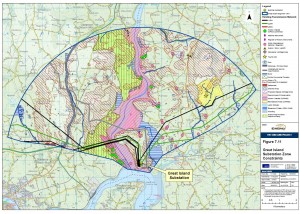
DETAILS OF the Grid Link Project linking Leinster and Munster were outlined to the members of both Wexford Co. Council and New Ross Town Council last week.
Following on from a presentation to members of the Co. Council on Monday the local authority in New Ross welcomed Michael Donnelly, from RPS, and Michael Moore, from Eirgrid, into the chamber on Tuesday night.
The members were informed that the primary purpose of the project will be to ensure there will be enough electricity generated to meet demand going forward.
Mr. Moore, who is involved with Eirgrid’s Planning, Operations and Development sector, said the project being developed is known as Gridlink.
“We are providing the capacity for future demand of electricity,” he said.
The members were informed the project would provide the south east with “a competitive edge” in addition to jobs and supporting economic growth.
Mr. Donnelly said €500m is being invested and that it will take eight to 10 years to develop. He said planning applications will be lodged with the local authority in 2016.
“We are at the end of Stage one now,” he said.
He went on to say that 110 different layers of data had been mapped to-date.
In relation to feedback to the proposals Mr. Donnelly said a number of concerns had been raise including why the power lines are not going underground, how will it impact on health and what will the impact be on property.
“The 12-week consultancy period will end on November 26,” he said.
Cllr. Jaz Callaghan reiterated the query as to why the power lines won’t be put underground.
In response Mr. Moore said the technology being developed will be ‘AC’ and that as such it won’t be suitable to be placed underground.
“The longest AC underground cable in Europe is 20km in length and is in an air-conditioned tunnel in London,” he said.
Cllr. John Dwyer asked if research had been done into what exposure the grid will give people to electromagnetic fields.
“That will be minimal,” replied Mr. Moore.
He then suggested that more electromagnetic fields are being generated from ordinary everyday domestic appliances than will be transmitted from the grid.
“Was such exposure ever considered?” asked Cllr. Dwyer – repeating his question.
“It will be considered at a future stage,” replied Mr. Moore.
Cllr. Michael Sheehan said the pipeline will effect New Ross and Enniscorthy primarily and he asked if the lines could be developed in conjunction with the proposed motorway bypasses of both towns and then placed underground.
He also asked what the grid will be connecting to and if windfarms will be linked to it.
Cllr. Sheehan also asked if CPO (Compulsory Purchase Orders) would be issued of landowners along the route choose not to engage with the project and lease their land to it.
The delegation was also asked how many pylons would be erected between New Ross and Enniscorthy.
“We are not looking at DC technology so there will be no opportunity to look at ducting within roadways,” replied Mr. Moore.
“It’s not feasible to go underground with this type of infrastructure,” he added.
Mr. Moore also informed the members that the grid will be linked to Knockraha, Co. Cork, Dunstown, Co. Kildare, and Great Island.
Mr. Moore confirmed that Eirgrid has the power to implement CPOs but added that it rarely does so.
“We issue way-leave notice to landowners for the right to construct and maintain,” he added.
He also informed the members that around 750 pylons will be located along the full 250km length of the proposed route.
Cllr. Niamh Fitzgibbon asked if a preferred route had been identified.
“We do not have a preferred route but we have a set of options,” replied Mr. Moore.
He said an evaluation process will be administered before final selection is carried out.
“The reason we did not do that is because it’s just in the early stages,” he said.
“We are not there yet and it will happen at the next stage.”
